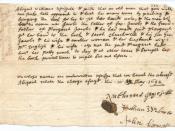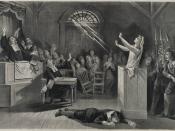"The Crucible", a play based on the Salem Witch Trials by Arthur Miller in 1953, strongly reflects on the flawed race of mankind. The flaws or weaknesses that are common to mankind are often represented in literature as well as real life. Weaknesses such as revenge, adultery, hysteria, and deceit plague the Puritan inhabited town of Salem. The town exercises no practice of separation of church and state. Religion and law are combined and one can be punished for sinning and speaking against the church. The flawed human race invokes conflict and panic throughout Salem; causing innocent lives to be lost and false truth to be believed resulting in tragedy.
One of these flaws that plague Salem is hysteria. Hysteria replaces logic with the belief that others are acting in an unbelievable and ridiculous manner. The hysteria spreads like wildfire throughout Salem. Any bit of gossip or talk could set up a complete wrong perception in the town.
In "The Crucible" hysteria is displayed in numerous ways such as when villagers are accused of witchcraft or when there are people who are believed to be possessed and bewitched. The hysteria .ends up meaning well for some of the characters such as Thomas Putnam. Putnam uses the hysteria throughout the town to his advantage by getting revenge on some of the other villagers. Revenge is another weakness the villagers of Salem display throughout the play. Putnam gets revenge on Francis Nurse by accusing Rebecca Nurse, Francis's wife, of murdering Ann Putnam's babies with witchcraft.
Along with hysteria and revenge Salem also witnesses acts of adultery; most notably the affair involving John Proctor and Abigail Williams. When Abigail is a servant for the Proctors she falls in love with John. When Elizabeth Proctor, John's wife, finds out about the affair she...


